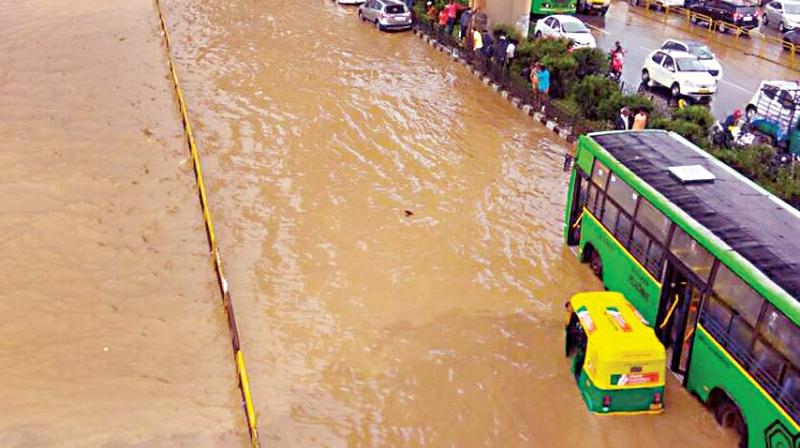Bengaluru: Pounding rains leave residents baffled
This year's rainy spells have inundated several parts of the city, with roads in many places turning into rivulets.

Bengaluru: India's Silicon Valley is struggling to cope with the onslaught of rain ever since August 15. Bengalureans, who had witnessed sweltering summer this year with temperatures touching 40 degree Celsius, were looking forward towards relief during this rainy season.
However, now they have to worry about salvaging their houses, vehicles amid rampaging monsoon. This year’s rainy spells have inundated several parts of the city, with roads in many places turning into rivulets. All those who yearned for rains, now want it to stop.
Venkatesh M, is almost nearing his 70s. Being born and brought up in the city, he said, "The city has witnessed tremendous change over the years not only in the form of infrastructure but also in weather. A city which was fondly called as pensioners' paradise is witnessing sudden changes in weather."
Festivals like Dasara and Onam used to mark the end of South west monsoon. But even in October we are seeing heavy rains, he noticed.
Regarding this freaky weather pattern, Srinivas Reddy, Director, Karnataka State Natural Disaster Monitoring Centre, said, "Summer was bit harsh this year with the temperatures hopping between 36 and 40 degrees making it very difficult. But when compared with the temperatures recorded in previous decade there isn't any sharp increase." However, he said that there is an increase of 1-2 degrees.
"We had predicted South west monsoon to make its entry into the state by May 27, but due to change in the system it got delayed. Usually, June and July months witness heavy rainfall. In 2016 too, June and July months witnessed heavy rainfall. But this year, till mid-July there were no signs of Monsoon picking up and out of 29 districts in the state, 21 were rain deficit," he said.
However, since August 15, it has been raining heavily breaking 100 year old rainfall records. Even though there isn't any big variation in the 100-year rainfall pattern, extreme events are taking place in the city with sudden spike in the intensity of rains.
Srinivas said that even in the city there is a wide difference in the amount of rainfall recorded. "While some areas record 100mm rains, some witness only 50 mm and in some there would have been no rains at all.
Srinivas attributed it to rising pollution levels and change in land use pattern and increasing concrete cover. "City's runoff coefficient (amount of runoff to the amount of precipitation received) which was at 30-40 per cent, is now at 80 per cent. Rapid concretisation has shrunk the exposed areas for the rainwater to seep into the ground."
“Everywhere you can find high rise building which use glasses. These glass houses may look attractive, but they are greenhouse trappers contributing to rise in temperature. Adding to these are vehicular and industrial pollution. All these factors influence the way rain behaves,” he said.
In addition, many lakes and tanks have made way for houses and layouts. Drains which are supposed to carry rainwater are now filled with filth and garbage.

